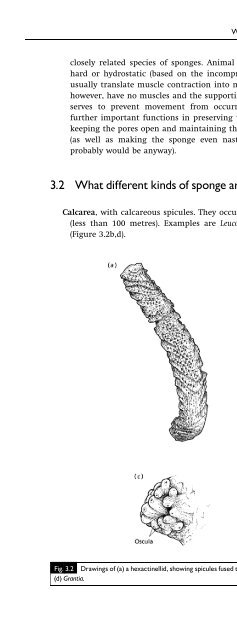- Page 2:
This page intentionally left blank
- Page 10:
cambridge university pressCambridge
- Page 14:
viCONTENTS4.5 What is the ecologica
- Page 18:
viiiCONTENTS13.5 What are the speci
- Page 24:
Boxes5.1 Muscle page 495.2 Protosto
- Page 30:
xivPREFACEfirst two, are more gener
- Page 36: Illustration acknowledgementsAll th
- Page 40: Chapter1The process of evolution:na
- Page 44: WHAT IS THE CELLULAR BASIS OF HERED
- Page 48: WHAT IS THE ORIGIN OF GENETIC VARIA
- Page 52: WHAT IN GENERAL DOES EVOLUTION PROD
- Page 56: WHAT IN GENERAL DOES EVOLUTION PROD
- Page 60: Chapter 2The pattern of evolution:m
- Page 64: HOW CAN WE USE MORPHOLOGY TO TRACE
- Page 68: HOW CAN WE USE FOSSILS TO INVESTIGA
- Page 72: CAN THE FOSSIL RECORD DATE THE EARL
- Page 76: WHICH MOLECULES ARE USED?19Using pa
- Page 80: HOW RELIABLE IS MOLECULAR TAXONOMY?
- Page 84: Chapter 3PoriferaSponges are by far
- Page 90: 26 PORIFERADemospongiae, with silic
- Page 94: 28 PORIFERAFig. 3.3 Sponge developm
- Page 98: 30 PORIFERAthrough the osculum. In
- Page 102: Chapter 4CnidariaCnidaria include t
- Page 106: 34 CNIDARIAFig. 4.2 (a) The nerve n
- Page 110: 36 CNIDARIAFig. 4.4 The structure o
- Page 114: 38 CNIDARIAFig. 4.5The structure of
- Page 118: 40 CNIDARIAFig. 4.6 Two cnidarian l
- Page 122: 42 CNIDARIAFig. 4.7 (a) Physalia, t
- Page 126: 44 CNIDARIAFig. 4.8 Diagrams of cor
- Page 130: 46 CNIDARIAas primitive. Mitochondr
- Page 134: 48 ONBEING AWORMWorms are ‘triplo
- Page 138:
50 ON BEING A WORM(b) Shortening of
- Page 142:
52 ON BEING A WORMGraphical represe
- Page 146:
54 ON BEING A WORM5.2.4 The disadva
- Page 150:
56 ON BEING A WORMFig. 5.3 The dive
- Page 154:
58 ON BEING A WORMMicrognathozoa. A
- Page 158:
60 ON BEING A WORMChaetognatha (Fig
- Page 162:
62 ON BEING A WORMDiagram showing t
- Page 166:
64 ONBEING A WORMcnidarian nematocy
- Page 170:
66 PLATYHELMINTHES AND ACOELOMORPHA
- Page 174:
68 PLATYHELMINTHES AND ACOELOMORPHA
- Page 178:
70 PLATYHELMINTHES AND ACOELOMORPHA
- Page 182:
72 PLATYHELMINTHES AND ACOELOMORPHA
- Page 186:
74 PLATYHELMINTHES AND ACOELOMORPHA
- Page 190:
76 NEMERTEAFig. 7.2 Diagrams showin
- Page 194:
78 NEMERTEAouter muscle layer is ci
- Page 198:
80 NEMERTEAthe tip attaches to the
- Page 202:
82 NEMERTEAThe blood does not seem
- Page 206:
84 NEMERTEA7.4 What diversity exist
- Page 210:
86 NEMERTEAis determined early, and
- Page 214:
88 NEMERTEALong-term adaptations to
- Page 218:
Chapter 8NematodaNematodes, or ‘r
- Page 222:
92 NEMATODAFig. 8.1 The structure o
- Page 226:
94 NEMATODA(most unusually) send pr
- Page 230:
96 NEMATODAchanged by this loss of
- Page 234:
98 NEMATODAFig. 8.3 Caenorhabditis
- Page 238:
100 NEMATODArate of nucleotide subs
- Page 242:
102 ANNELIDAFig. 9.1 Diagrammatic t
- Page 246:
104 ANNELIDAeither layer. Protoneph
- Page 250:
106 ANNELIDAenables each to move in
- Page 254:
108 ANNELIDA9.4 How does a coelom i
- Page 258:
110 ANNELIDADiagram to show the bas
- Page 262:
112 ANNELIDAin some members of almo
- Page 266:
114 ANNELIDASeawater transport syst
- Page 270:
116 ANNELIDAFig. 9.5 A polychaetetr
- Page 274:
118 ANNELIDAa collection of small a
- Page 278:
Chapter10Mollusca: generaland Gastr
- Page 282:
122 MOLLUSCA: GENERAL AND GASTROPOD
- Page 286:
124 MOLLUSCA: GENERAL AND GASTROPOD
- Page 290:
126 MOLLUSCA: GENERAL AND GASTROPOD
- Page 294:
128 MOLLUSCA: GENERAL AND GASTROPOD
- Page 298:
130 MOLLUSCA: GENERAL AND GASTROPOD
- Page 302:
132 MOLLUSCA: GENERAL AND GASTROPOD
- Page 306:
134 MOLLUSCA: GENERAL AND GASTROPOD
- Page 310:
136 MOLLUSCA: BIVALVIA AND CEPHALOP
- Page 314:
138 MOLLUSCA: BIVALVIA AND CEPHALOP
- Page 318:
140 MOLLUSCA: BIVALVIA AND CEPHALOP
- Page 322:
142 MOLLUSCA: BIVALVIA AND CEPHALOP
- Page 326:
144 MOLLUSCA: BIVALVIA AND CEPHALOP
- Page 330:
146 MOLLUSCA: BIVALVIA AND CEPHALOP
- Page 334:
148 MOLLUSCA: BIVALVIA AND CEPHALOP
- Page 338:
150 MOLLUSCA: BIVALVIA AND CEPHALOP
- Page 342:
152 MOLLUSCA: BIVALVIA AND CEPHALOP
- Page 346:
154 ARTHROPODA: GENERAL12.1 What de
- Page 350:
156 ARTHROPODA: GENERALcuticle belo
- Page 354:
158 ARTHROPODA: GENERALunder hormon
- Page 358:
160 ARTHROPODA: GENERALdifferences:
- Page 362:
162 ARTHROPODA: GENERALBehind the b
- Page 366:
164 ARTHROPODA: GENERALFig.12.7 (co
- Page 370:
166 ARTHROPODA: GENERALFig.12.8 Non
- Page 374:
Chapter13CrustaceaCrustacea include
- Page 378:
170 CRUSTACEAa few millimetres in l
- Page 382:
172 CRUSTACEApenetrate estuaries (e
- Page 386:
174 CRUSTACEAFig.13.4 The diversity
- Page 390:
176 CRUSTACEAFig.13.6 The diversity
- Page 394:
178 CRUSTACEAare recognisable crust
- Page 398:
180 CRUSTACEA13.7 How are Crustacea
- Page 402:
182 CHELICERATA AND MYRIAPODA14.2 W
- Page 406:
184 CHELICERATA AND MYRIAPODAFig.14
- Page 410:
186 CHELICERATA AND MYRIAPODAsepara
- Page 414:
188 CHELICERATA AND MYRIAPODA14.5.3
- Page 418:
190 CHELICERATA AND MYRIAPODAdorsov
- Page 422:
Chapter15InsectaMost animals are in
- Page 426:
194 INSECTAFig.15.1 Insect tracheal
- Page 430:
196 INSECTAWhile the essential requ
- Page 434:
198 INSECTAmeet the airstream over
- Page 438:
200 INSECTAFig.15.3 Insect flight m
- Page 442:
202 INSECTA15.5 What are the main o
- Page 446:
204 INSECTAcaptures a female and fl
- Page 450:
206 INSECTAThere are other smaller
- Page 454:
208 INSECTAlike nets of gauze and a
- Page 458:
210 INSECTAreproductive potential?
- Page 462:
212 INSECTA15.7.4 Modern geneticsAc
- Page 466:
214 ANIMALS WITH LOPHOPHORESFig.16.
- Page 470:
216 ANIMALS WITH LOPHOPHORESand a g
- Page 474:
218 ANIMALS WITH LOPHOPHORES16.3.2
- Page 478:
220 ANIMALS WITH LOPHOPHORESBox 16.
- Page 482:
Chapter17EchinodermataEchinoderms i
- Page 486:
224 ECHINODERMATAcan be serviced by
- Page 490:
226 ECHINODERMATAFig.17.2 The struc
- Page 494:
228 ECHINODERMATAring but in the ra
- Page 498:
230 ECHINODERMATAFig.17.6Diagram co
- Page 502:
232 ECHINODERMATATypically holothur
- Page 506:
234 ECHINODERMATAbe accompanied by
- Page 510:
Chapter18Invertebrate Chordata andH
- Page 514:
238 INVERTEBRATE CHORDATA AND HEMIC
- Page 518:
240 INVERTEBRATE CHORDATA AND HEMIC
- Page 522:
242 INVERTEBRATE CHORDATA AND HEMIC
- Page 526:
244 INVERTEBRATE CHORDATA AND HEMIC
- Page 530:
246 INVERTEBRATE CHORDATA AND HEMIC
- Page 534:
248 DEVELOPMENTpolarity and the int
- Page 538:
250 DEVELOPMENTThe first steps of c
- Page 542:
252 DEVELOPMENTFig.19.3 Nematode (A
- Page 546:
254 DEVELOPMENTmethod called ‘epi
- Page 550:
256 DEVELOPMENTconcentrations is ca
- Page 554:
258 DEVELOPMENTFig.19.6 Regeneratio
- Page 558:
260 DEVELOPMENT3. Hox genes are alw
- Page 562:
262 DEVELOPMENTthe current focus is
- Page 566:
264 INVERTEBRATE EVOLUTIONARY HISTO
- Page 570:
266 INVERTEBRATE EVOLUTIONARY HISTO
- Page 574:
268 INVERTEBRATE EVOLUTIONARY HISTO
- Page 578:
270 INVERTEBRATE EVOLUTIONARY HISTO
- Page 582:
272 INVERTEBRATE EVOLUTIONARY HISTO
- Page 586:
274 INVERTEBRATE EVOLUTIONARY HISTO
- Page 590:
276 INVERTEBRATE EVOLUTIONARY HISTO
- Page 594:
278 INVERTEBRATE EVOLUTIONARY HISTO
- Page 598:
280 INVERTEBRATE EVOLUTIONARY HISTO
- Page 602:
282 INVERTEBRATE EVOLUTIONARY HISTO
- Page 606:
284 FURTHER READINGR. McNeil Alexan
- Page 610:
286 FURTHER READINGSymposium (2003)
- Page 614:
288 FURTHER READINGC. P. Ellington,
- Page 618:
290 FURTHER READINGJ. W. Valentine,
- Page 622:
292 FURTHER READINGA. S. Monteiro,
- Page 626:
GlossaryWords in italic have their
- Page 630:
296 GLOSSARYBuoyancy Neutral buoyan
- Page 634:
298 GLOSSARYDepolarisation Applied
- Page 638:
300 GLOSSARYGamete The haploid unit
- Page 642:
302 GLOSSARYIntrovert Front end of
- Page 646:
304 GLOSSARYMitosis Division of the
- Page 650:
306 GLOSSARYOssicle Skeletal unit o
- Page 654:
308 GLOSSARYRadial cleavage Cleavag
- Page 658:
310 GLOSSARYTagma Region of an arth
- Page 664:
IndexBold numbers denote figures an
- Page 668:
INDEX315model animal 3, 192, 210-12
- Page 672:
INDEX317in chordates 237, 238, 240h
- Page 676:
INDEX319Tail 236, 237, 240, Fig. 18











